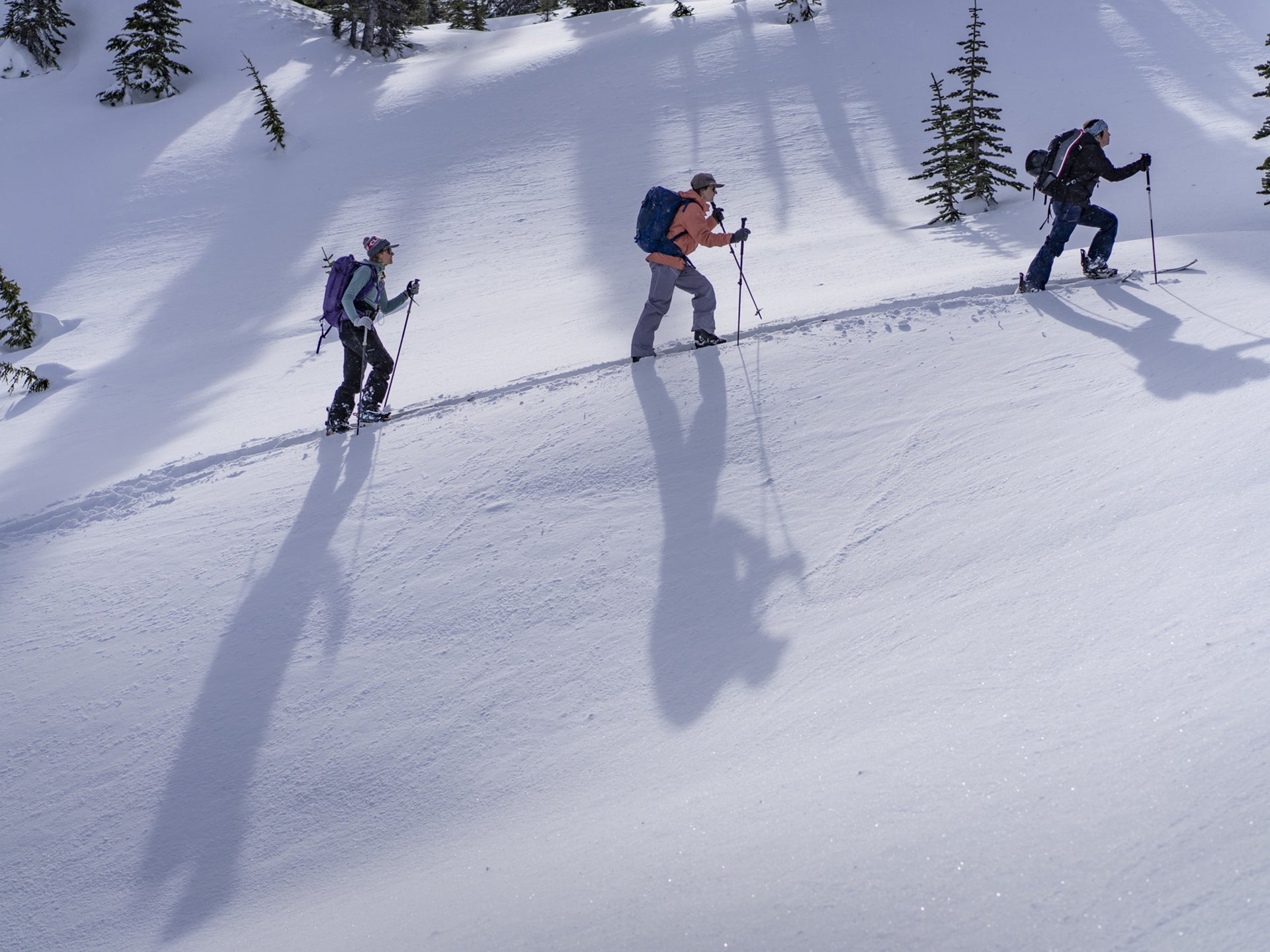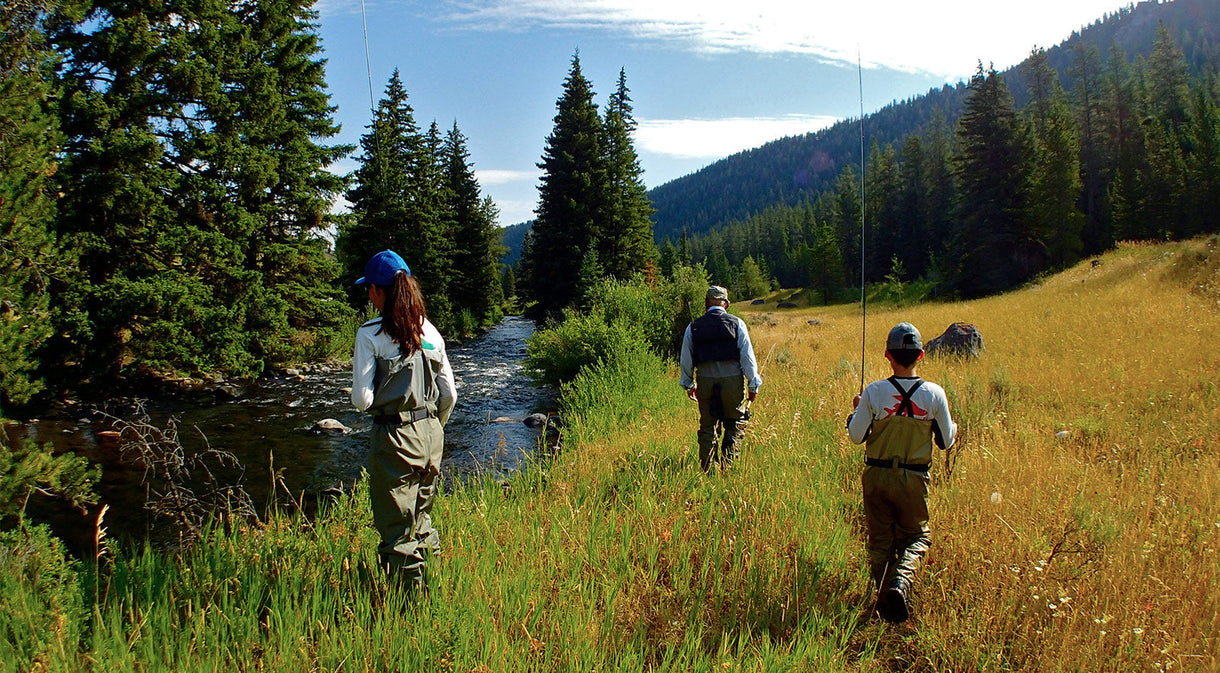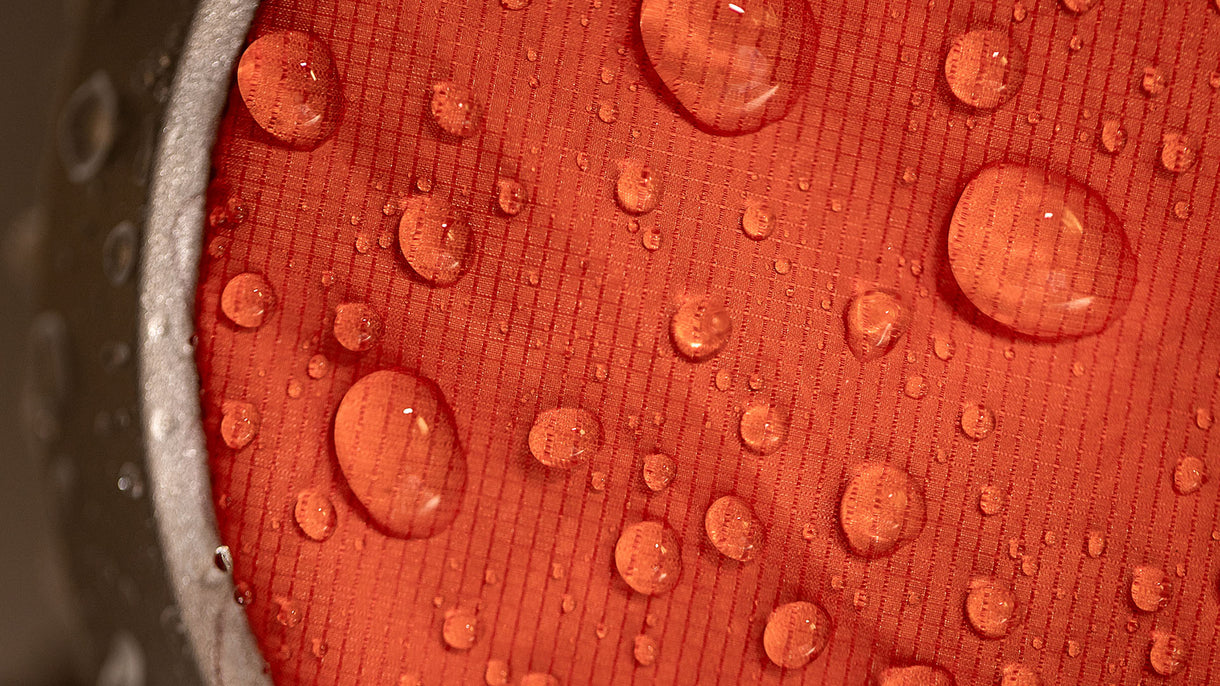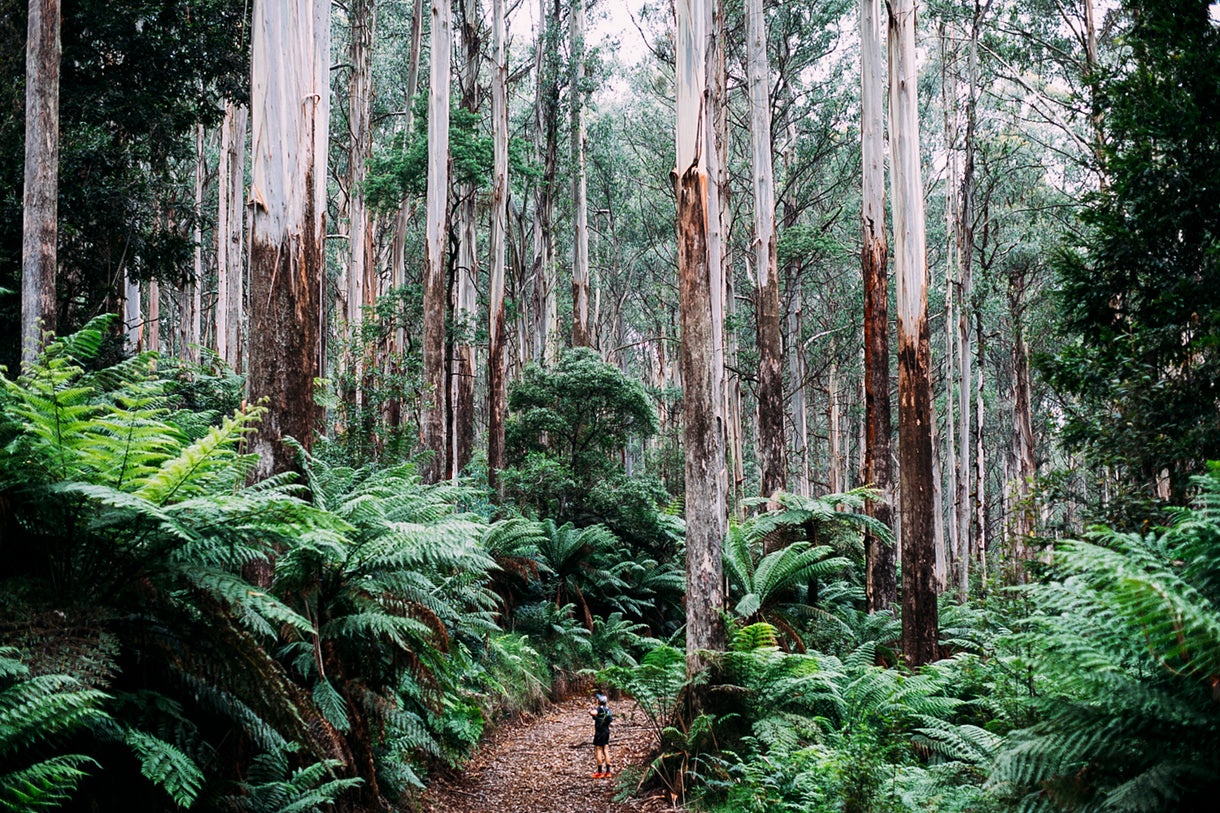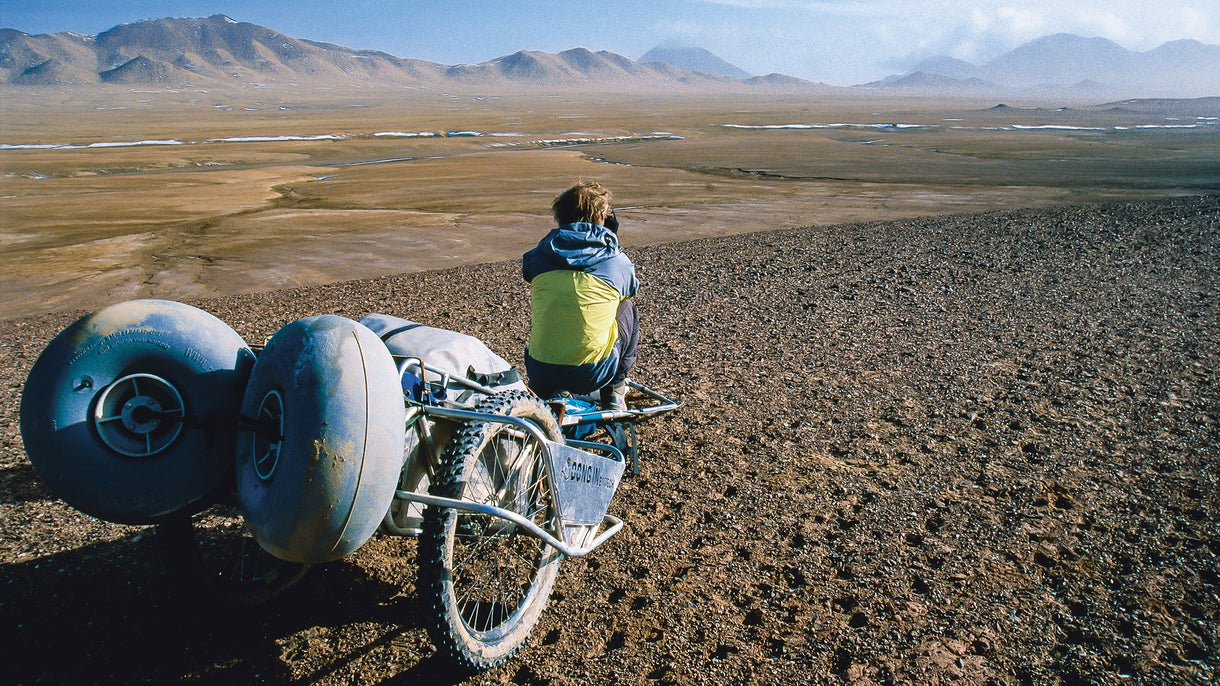Reciprocal learning while exploring traditional Indigenous territories in British Columbia.
All photos by Mason Mashon
As you move away from the tourist buzz of the “Sea to Sky” corridor on the British Columbia coast, you get a glimpse of true nature. A feeling of belonging and space to understand how sacred the mountains are.
In February 2020, we ventured out into the traditional territories of the Sḵwx̱wú7mesh and Líl̓wat Nations with Marie-France Roy and Leah Evans. As early morning sunlight peeked through the trees, the four of us talked about the history of these lands and about the significance of the Douglas fir and the lichen that hangs upon its branches. Leah and Marie taught us the science behind how they grow and where they thrive, while we taught them the cultural significance of these plants and the medicines they hold. It was the beginning of a journey of reciprocal learning with this amazing group of skiers and snowboarders.
On Sandy’s traditional territory of the Líl̓wat Nation, we immersed ourselves in the stories of the Líl̓wat people. The landscapes unfolding in front of us provided a visual to support the tales. Then, on the traditional territory of the Sḵwx̱wú7mesh people, Myia’s lands, we saw the ocean and the mountains collide, forming storylines that have been told since time out of mind. Skiing together with other Indigenous women allowed us to form deeper connections with our own territories and each other’s. We learned how to respect each other’s cultures and protocols and share our way of life with our non-Indigenous friends. Being outside together felt as though we were walking with our ancestors and learning from them, even though they have long passed.
What follows is a conversation on the significance of walking through each other’s lands—reflections on what this land means to us and to one another.

Sandy shows Myia Antone the location of the Líl̓wat avalanche rescue story, which took place close to where they are standing.
Sandy Ward: Have you ever been out exploring the wilderness in seemingly untouched terrain and wondered what stories the landscape holds? Those trees and rocks have seen generations go by, creating legends and gathering knowledge of medicines and ancestral ways of life, those long lost in time—or so we thought. With Indigenous peoples returning to their communities and re-learning our history and culture, these teachings are making a comeback. These stories are passed down from Elders to youth: legends of ancient beings, accounts of achievements and tales of sorrow. Indigenous peoples all over North America have teachings in every story and song from the land, and if we are ready to learn, we can do so. We just need to listen.
We have always been told that our ancestors are with us wherever we go. In my homelands of the Líl̓wat Nation, tucked in the Coast Mountains of British Columbia, our legends make up the landscapes. They warn us of dangers within the territory and provide landmarks to guide us for distances or directions to hunting grounds.
Every story has a meaning. Sometimes you need to dig deep to find it, but it is there. We have stories of the “Transformers,” ancient beings that walked through our territory changing men and animals into stone. A seemingly cruel punishment, but rather, it was a way for us to navigate our lands and know the boundaries of our territory as well as to induce a sense of morality. They would tell us about glacier travel, the best time of year to cross them and which routes were the safest, or they would map out the rivers with names for important places or monuments in the landscape.

Early morning sun awakens the Howe Sound in Sḵwx̱wú7mesh territory.
Myia Antone (Welwál̓tnaat): I am reminded who I come from when I see the fresh water meet the salt water in Howe Sound. I hear the language of my ancestors when the wind rustles the trees. I could never be who I am meant to be without slowing down and listening to the stories that make the Sḵwx̱wú7mesh stélmexw (Squamish people) who we are. Our language, teachings and stories come directly from the land. Land that is so often skied over or rappelled off. Land that holds knowledge of how to take care of each other, talk to each other, protect each other. Land that is continuously speaking to us, whether we choose to listen or not.
We are all storytellers, including the land that we walk upon. We hold the power and autonomy to tell our own narratives and must learn to listen to and respect each other’s stories. The stories the land tells and the way we travel on them depends on the way our territories were shaped by the Creator. My territory’s stories (Sḵwx̱wú7mesh temíxw) are made up of mountains, rivers, glaciers, forests and the Pacific Ocean. Stories as glorious as mountain peaks, so deep like the remaining old-growth forests, with an abundance of everything, as vast as the ocean itself.

Marie-France does a method air in the Ntáoz’a forest on Líl̓wat territory.
Sandy: While we were in my traditional territory up toward Nlháxaten (Duffey Lake/Cayoosh Creek Valley), we talked about how our stories would not just map out the landscape, but they would tell us of great warriors or community achievements. As we were standing in the bright sun overlooking Nlháxaten, I had the honor of telling one such story, “The Mountain Rescue,” to Myia, Marie-France and Leah. It took place in the early 1900s and shows how our people care for each other. It took an entire community to bring two lost men home to Líl̓wat after they were buried in an avalanche in the very area that we were touring that day. The narrative not only shows our support for each other as a community but also tells of the dangers involved in winter travel and what to watch out for in avalanche terrain—knowledge that is still relevant today.
How can you better connect with the lands that you are recreating on? Read and learn from the stories of the Nations whose land you are on. Traditional Ecological Knowledge (TEK) is now being respected by non-Indigenous peoples and is in use throughout Canada as a guide to our lands and a source of knowledge about wildlife and resources. It can help us protect and preserve our territories. In Lil’wat, we had people that we called tewít—a very skilled hunter usually in charge of the resources in a specific area. They would keep track of the herds and resources in an area, and everyone was expected to ask permission from the tewít to hunt and gather in these places. TEK teaches us how to maintain balance and harmony within our territories by listening to the stories from our lands.

Leah amongst Douglas firs in Sḵwx̱wú7mesh and Líl̓wat shared territory.
Myia: We spent a couple days in Sandy’s territory. I had to constantly remind myself that I was a guest, as we were all guests except for Sandy. She was so generous with her words, and we listened to her speak Ucwalmícwts, a language that fits so perfectly into every nook and cranny of Líl̓wat landscape. We heard the stories of their community, stories of love, knowledge and reciprocity. How could you not feel more connected to a place when you know the real history of it, a history that spans so many generations we’ve lost count?

Left: Sandy enjoys deep powder on the shared territory of the Sḵwx̱wú7mesh and Líl̓wat peoples.
Right: Sandy shares a moment of stoke with Leah as they look back at their fresh tracks.
Sandy: Watching the sunrise over Myia’s territory was an unforgettable shared experience. As the sun was just starting to hit the tusk of Q’elqámtensa lti Skenknápa (The Roost of the Thunderbird), we talked about how our two nations shared a village (called Spo7ez) and how we are connected as people and tied to this landscape together.
As outdoor recreationalists, we have a responsibility to the land that we cannot ignore. It’s fun to go out and play on it, but we need to remember to protect it so future generations have that ability to go out and enjoy it like we do. In hearing Myia’s stories, I found a new respect for the Squamish Nation and their territory. A respect that we can all learn from if we take the time and work for it. Once we can all thrive together and learn from each other, only then can we learn from the land and know how to protect her.
In Lil’wat we have a saying: Pelpala7wít i ucwalmícwa múta7 ti tmícw, the people and the land are one. One can’t be acknowledged without the other and understanding both is needed to achieve full reconciliation.

Sandy and Leah watch the moon set over the Tantalus Range in Sḵwx̱wú7mesh territory.
Myia: The full moon sat above the Tantalus Range as the pink from the sunrise started filling the sky. Our crew got to the top as the sun rose, hitting T’aḵ’t’aḵ’mú’y̓in tl’a In7iny̓áx̱e7en (Landing Place of the Thunderbird), and I realized these times of serenity deeply connect even strangers in one moment. The sun warmed my territory, and we experienced, together, how healing the mountains are for each of us. We see and know how the land gives us so much, but what do we give back?

Left: Sandy playfully sprays Myia in their shared territory, now known as Whistler, BC.
Right: Marie-France happily contemplates another lap.
Sandy: This was my first time out in the backcountry with another Indigenous woman, and it was so inspiring to learn and hear about our different lands and histories. It showed me that backcountry snowboarding can be so much more than just an adventure in the snow—it should be a learning experience, a chance to bond with our fellow adventurers.

Myia digs into fresh máḵa7, which means “snow” in the Sḵwx̱wú7mesh language.
Myia: Sometimes we go to the forest, the ocean, our Elders or our friends and family for help. Our medicine can be the waves crashing on the rocks, the fern growing on the tallest tree or a hug from a loved one. But we also have to remember that while we are looking for medicine elsewhere, sometimes it can be found in sliding down a mountain with your best friends or lunchtime chats sitting on a mountain top while snow falls.
My heart felt happy watching the pride in Sandy’s eyes as she told us the stories from her community. Her hands waved around, trying to keep up with the words flowing from her mouth. We found similarities in our stories, where our languages overlapped or where they differed. I wondered how our Nations could be neighbors. Healing comes in different forms, but my favorite medicine is getting out on the land with my Indigenous sisters.
Skiing has allowed me to reclaim parts of my territory by visiting them. This reclamation of stories and power has weaved itself into all other aspects of my life, and I am reminded that skiing is never just a solitary activity. Not only am I surrounded by friends, trees and animals, but I am constantly working on myself for the betterment of my community and my future children. Skiing takes me to magical places with new and old friends, and I bring every piece of my being to these moments. That includes my ancestors, who got me to where I am, and my descendants, who will take over my responsibility once I am gone. This land is where my responsibility lives.
We constantly learn throughout our lifetime. But what is our responsibility to the lands and waters that provide for us? How do we bring reciprocity into all pieces of our lives, including skiing? How do we say thank you to the land when it already asks for nothing in return? How do we thank the communities who allow us to occupy their territories and ski their mountains? I once heard that the best thanks you can give is to teach all you’ve learned to someone else. So, what have you learned here and who are you going to share it with?

First light touches the peak known as T’aḵ’t’aḵ’mú’y̓in tl’a In̓inyáx̱a7n in Sḵwx̱wú7mesh, Q’elqámtensa lti Skenknápa in Líl̓wat, and The Black Tusk in English.
Sandy: I invite you to learn with us, as much as you can, about whose territory you are adventuring on and the stories that go along with that landscape. Next time you are in a First Nations community, a smile and a wave go a long way. You might even find yourself enjoying a riverside feast of t̓áqsa7. Don’t know what that is? Come find out.
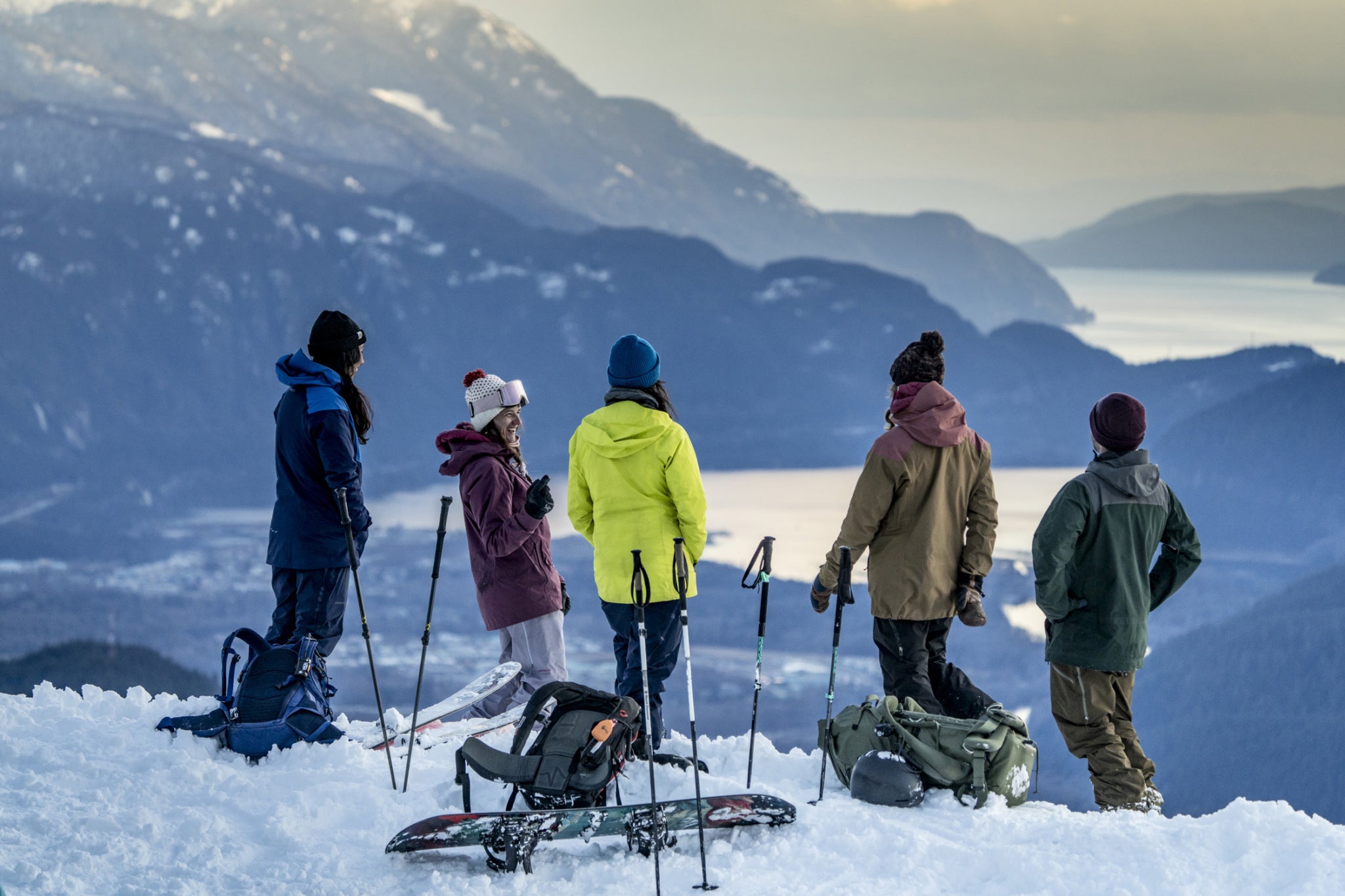
The crew taking in the sunset over Sḵwx̱wú7mesh territory as they recount four days spent together in the mountains. According to Sandy and Myia, they said their goodbyes, but knew their journey together wasn’t over. Rather, it was just the beginning of a long journey of learning and sharing stories.


